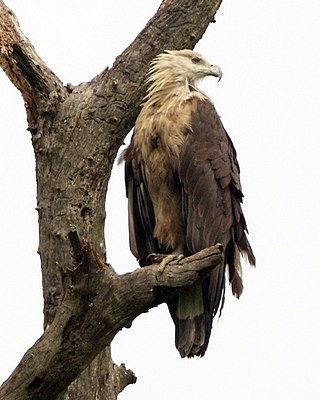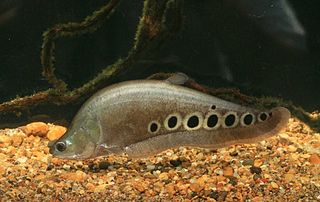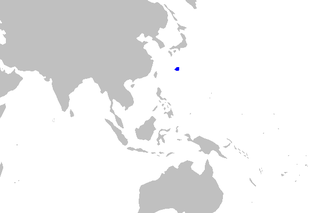
The Chinese paddlefish, also known as the Chinese swordfish, is an extinct species of fish that was formerly native to the Yangtze and Yellow River basins in China. With records of specimens over three metres and possibly 7 m (23 ft) in length, it was one of the largest species of freshwater fish. It was the only species in the genus Psephurus and one of two recent species of paddlefish (Polyodontidae), the other being the American paddlefish. It was an anadromous species, meaning that it spent part of its adult life at sea, while migrating upriver to spawn.

Elasmobranchii is a subclass of Chondrichthyes or cartilaginous fish, including sharks, rays, skates, and sawfish. Members of this subclass are characterised by having five to seven pairs of gill clefts opening individually to the exterior, rigid dorsal fins and small placoid scales on the skin. The teeth are in several series; the upper jaw is not fused to the cranium, and the lower jaw is articulated with the upper. The details of this jaw anatomy vary between species, and help distinguish the different elasmobranch clades. The pelvic fins in males are modified to create claspers for the transfer of sperm. There is no swim bladder; instead, these fish maintain buoyancy with large livers rich in oil.

Pallas's fish eagle, also known as Pallas's sea eagle or band-tailed fish eagle, is a large, brownish sea eagle. It breeds in the east Palearctic in Kazakhstan, Russia, Tajikistan, Turkmenistan, Uzbekistan, Mongolia, China, India, Nepal, Bangladesh, Myanmar and Bhutan. It is listed as Endangered on the IUCN Red List. It is partially migratory, with Central Asian birds wintering among the southern Asian birds in northern India, and also further west to the Persian Gulf.

The northern river terrapin is a species of riverine turtle native to Southeast Asia. It is classified Critically Endangered by the IUCN and considered extinct in much of its former range.

The family Notopteridae contains 10 species of osteoglossiform (bony-tongued) fishes, commonly known as featherbacks and knifefishes. These fishes live in freshwater or brackish environments in Africa and South and Southeast Asia.

The bala shark also known as the tricolor shark, tricolor sharkminnow, silver shark, or shark minnow, is a fish of the family Cyprinidae, and is one of the two species in the genus Balantiocheilos. This species is not a true shark, but is commonly so called because of its torpedo-shaped body and large fins.

The rasptooth dogfish is a dogfish, found on the Kyushu–Palau Ridge in the northwest Pacific Ocean at depths of 360 m. Its maximum length is unknown. This species was originally described as Centroscyllium sheikoi, and subsequently allocated to the newly named genus Miroscyllium based on anatomical features not shared with other Centroscyllium. More recent molecular data suggest this species belongs to the genus Etmopterus, but as of June 2014 Miroscyllium sheikoi remains the valid name recognized by FishBase, the Catalog of Fishes World Register of Marine Species, and the IUCN

Balantiocheilos is a small genus of cyprinid fish from southeast Asia. It includes two species.

The red-and-blue lory is a small, strikingly-colored parrot endemic to Indonesia. The species inhabits a single island, Karakelong, in the Indonesian archipelago, although it was formerly found on the Sangihe Islands and other parts of the Talaud Islands.

The clown featherback, clown knifefish, or spotted knifefish, Chitala ornata, is a nocturnal tropical fish with a long, knife-like body. This knifefish is native to freshwater habitats in Cambodia, Laos, Thailand, and Vietnam, but it has also been introduced to regions outside its native range. It is one of the world's most invasive species.

The royal knifefish or Indochina featherback, Chitala blanci, is a species of ray-finned fish in the family Notopteridae found in the Mekong basin in Cambodia, Laos, Thailand and Vietnam.

Chitala is a genus of fish of the family Notopteridae. This genus contains six species, in which some are important in aquaculture and the aquarium industry. They are commonly known as the Asian knifefishes or featherbacks. They are native to freshwater in South and Southeast Asia.

An anchovy is a small, common forage fish of the family Engraulidae. Most species are found in marine waters, but several will enter brackish water, and some in South America are restricted to fresh water.

The Lake Sentarum National Park is a national park protecting one of the world's most biodiverse lake systems, located in the heart of Borneo Island, Kapuas Hulu Regency, West Kalimantan Province, Indonesia. It lies in the upper Kapuas River tectonic basin some 700 kilometres upstream from the delta. The basin is a vast floodplain, consisting of about 20 seasonal lakes, freshwater swamp forest and peat swamp forest. Local people call it as Lebak lebung (floodplain). The National Park is located in the western part of this basin, where three-quarters of the seasonal lakes occur. Approximately half of the park consists of lakes, while the other half consists of freshwater swamp forest.

The bronze featherback is a ray-finned fish in the family Notopteridae found in South and Southeast Asia. Although primarily found in fresh water, it has been known to enter brackish water. At present, it is the only member of the genus Notopterus, but as currently defined, it is likely a species complex.

Chitala chitala is a knifefish from Bangladesh, India, Nepal, and Pakistan, found in the Brahmaputra, Indus, Ganges and Mahanadi River basins. It is sometimes known as the Indian featherback or Indian knifefish. In the past, it frequently included several related Chitala species, but these are now regarded as separate species. The main species confused with this species is C. ornata ; a Southeast Asian species seen regularly in the aquarium trade. The true C. chitala is very rare in the aquarium trade.
The Indonesian featherback is a species of knifefish from freshwater habitats in Southeast Asia. The details of its range are not entirely clear, with FishBase reporting that it occurs in Sumatra, Borneo, and the Malay Peninsula, while Catalog of Fishes considers it endemic to Borneo.

Palembangese cuisine is the cuisine of the Palembangese people of the city of Palembang in the South Sumatra province of Indonesia. It is the second most well-known cuisine from Sumatra after Padang.

















